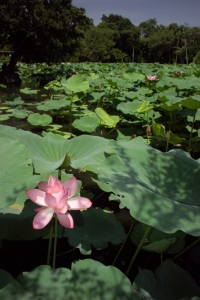|
Tags: garden | plant
The Lotus (Nelumbo nucifera) is popularly known as the Water-Lily. This plant is an aquatic perennial, the lotus roots are planted in the soil of the pond while the leaves float on top of the water surface. The flowers are usually found on crisp thick rootstock (Rhizome) or thin long stalks(Mi). The Lotus has fully circular leaves with two pairs of opposite hollows and the buoyant leaves can float on top of the water surface because of waxy pubescent cuticle structure. The first two leaves are like lily pads – round, flat and floating over the water called He-Qian or porter-leaves. The true leaves will emerge later, uncurling from a tightly wrapped sharp spike elevated high above the water's surface, it is called a shoot. They have long stalks scattered with small thorns and the leaves are covered with tiny acanthi to hold the leaves on the water surface. They ultimately become pink flowers with fragrance constituting the yellow stamens. After the flowers fade, the plumules (large seed cases) turn from yellow to green and then dark brown in maturity; the round or oblong seeds are hiding in the upper cupule or fleshy capsule.
Water lilies (Nymphaeaceae) and lotus (Nelumbo nucifera Gaertn.) are genetically very different. Botanists have noted the division of plant family. The leaves of water lilies have a single characteristic notch from the edge in to the centre of the lilypad, seedless pod, a number of different cultivars and colour ranges. There are also day-bloomers or night-bloomers. Common usages of water lilies are for flower arrangements or garden decoration.
Every part of the lotus is edible. The remnant rootstock will grow new leaves in early spring and blooms when it is a mature bud. When the lotus blooms, they reveal an amazing internal arrangement that revolves around an eye-catching centre. By the end of autumn, the growth of its pure beauty from the mud of its origin holds a compelling spiritual promise. The lotus’s opening and closing is an extraordinary process. Next, the petals fall off, revealing a soft yellow seedpod covered with small holes containing the round, long lasting seeds. Over a period of time, the distinctive seedpod expands in size and dries to a hard brown finish which turns dormant. It represents another kind of charming dreariness.
Typical marginal plants, such as land Salicaceae (Salix warburghii O. Seem.) and Juglandaceae (Pterocarya) are planted in areas surrounding Lotus Pond. There are some animals that are released to free, such as Mouthbreeder, Anglerfish, Brazil Tortoise, Pomacea canaliculated (Lamarck), could affect the ecological balance and growth of lotus in the pond.

|

|
| Nelumbo nucifera Gaertn. |
Hibiscus taiwanensis S. Y. Hu |
Taipei Botanical Garden (TPBG) , Taiwan Forestry Research Institute.
|














